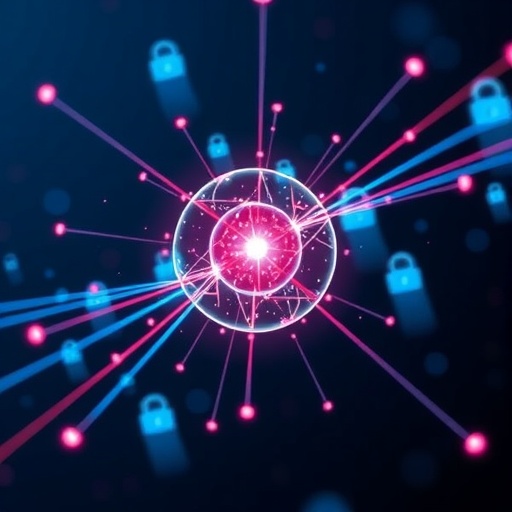In a breakthrough that promises to revolutionize the field of secure communications, physicists have unveiled a pioneering approach to quantum encryption that overcomes longstanding technical hurdles. For over forty years, the implementation of quantum key distribution (QKD) protocols—systems that leverage the fundamental principles of quantum mechanics to enable theoretically unbreakable encryption—has been held back by the crucial requirement of perfect single-photon sources. These idealized light emitters generate one photon at a time, a necessity for ensuring the highest levels of security in quantum communication channels. However, fabricating such flawless photon sources has proven prohibitively challenging, costly, and complex, impeding the transition of QKD from experimental laboratories to real-world applications.
Traditionally, the field has relied on attenuated lasers to mimic single-photon emission. These lasers produce weak light pulses containing a probabilistic mix of photons, including multi-photon events that can potentially be exploited by eavesdroppers to extract confidential information without detection. This innate imperfection strictly limits the secure communication range and reduces the robustness of QKD systems. Consequently, this gap between theoretical perfection and experimental feasibility has presented a critical obstacle for decades.
Addressing this fundamental challenge, a research team led by PhD students Yuval Bloom and Yoad Ordan—guided by Professor Ronen Rapaport at the Racah Institute of Physics, Hebrew University—collaborated closely with experts from Los Alamos National Laboratory to devise innovative protocols that embrace, rather than evade, the realities of imperfect hardware. Their work, recently published in PRX Quantum, introduces a practical methodology that harnesses sub-Poissonian photon sources based on quantum dot technology, moving quantum-safe encryption markedly closer to everyday, scalable implementation.
Quantum dots—nanoscale semiconductor particles behaving like artificial atoms—are key to this advancement. By dynamically engineering their optical emission characteristics and coupling them with nanoantenna structures, the researchers fine-tuned the quantum dots’ photon output. Unlike traditional sources, these engineered quantum dots can suppress the probability of multi-photon emissions, albeit without achieving absolute perfection. The team’s insight was to develop encryption schemes explicitly designed to operate optimally within the constraints imposed by such imperfect photon statistics.
Central to their approach are two novel protocols: a truncated decoy state protocol and a heralded purification protocol. The truncated decoy state method refines conventional decoy-state QKD techniques by tailoring the statistical treatment of emitted photons, effectively filtering out or discounting data vulnerable to interception due to multi-photon pulses. Meanwhile, the heralded purification protocol implements real-time “filtering” of signals, selectively verifying genuine single-photon events and discarding ambiguous or potentially insecure signals. This dual strategy dramatically elevates the security of transmitted keys while maintaining practical feasibility.
Extensive simulations paired with laboratory experiments demonstrated that the combined protocols substantially outperform current leading laser-based QKD systems. By improving photon emission control and carefully calibrating the encryption protocols, the team achieved over a 3-decibel gain in secure communication range—an extraordinary milestone indicating a tangible leap forward in how far quantum encryption can effectively operate. This enhancement translates directly to longer distances over which encrypted messages can be transmitted with uncompromised security, potentially bridging the gap between localized laboratory experiments and real-world quantum networks.
To validate their conceptual designs beyond theoretical constructs, the researchers established a working quantum communication system utilizing a room-temperature quantum dot source. They integrated their reinforced variant of the renowned BB84 QKD protocol—historically foundational in quantum cryptography—and showcased its viability under realistic conditions. The results were compelling: the system maintained strong security assurances without the need for prohibitively demanding hardware precision, a testament to the power of adapting protocols to practical device capabilities.
The implications of this research extend far beyond academic curiosity. By reducing the technological and financial barriers associated with perfect single-photon sources, these methods democratize access to quantum cryptography. Laboratories and enterprises worldwide equipped with existing quantum dot sources and compatible light-emitting setups can potentially adopt robust quantum-secure communication protocols immediately, accelerating the proliferation of next-generation encryption standards resilient against threats from increasingly powerful computational adversaries, including future quantum computers.
Professor Ronen Rapaport emphasized the practical significance of the breakthrough: “This is a significant step toward practical, accessible quantum encryption. It shows that we don’t need perfect hardware to get exceptional performance—we just need to be smarter about how we use what we have.” The sentiment highlights a paradigm shift in quantum technology development, where strategic algorithmic innovations compensate or even benefit from physical imperfections.
Yuval Bloom, co-lead author of the study, elaborated on the broader vision: “We hope this work helps open the door to real-world quantum networks that are both secure and affordable. The cool thing is that we don’t have to wait; it can be implemented with what we already have in many labs worldwide.” These words underscore the immediacy of the potential impact, marking a path toward widespread quantum-secure infrastructure.
Beyond enhancing security and reach, the approaches are adaptable to a diverse range of quantum light sources, opening further avenues for integration across different platforms. This versatility could catalyze a more agile and cost-effective deployment of long-awaited quantum communication networks, incorporating quantum repeaters, satellites, and fiber optics into unified, secure information highways.
In sum, the fusion of engineered quantum dot emitters with smart encryption protocols signals a transformative chapter in the evolution of quantum cryptography. As the world grapples with increasing cybersecurity demands amid looming threats posed by the quantum computing era, these developments offer a beacon of practical hope. By redefining the prerequisites for secure quantum communication, this work not only solves a longstanding theoretical challenge but also invites a future where quantum-safe encryption becomes ubiquitous, dependable, and accessible.
Subject of Research:
Not applicable
Article Title:
an
News Publication Date:
21-Aug-2025
Web References:
http://dx.doi.org/10.1103/7fdd-m92n
Image Credits:
Lars Luder
Keywords:
Quantum mechanics; Physics; Quantum computing; Quantum algorithms; Computational science




